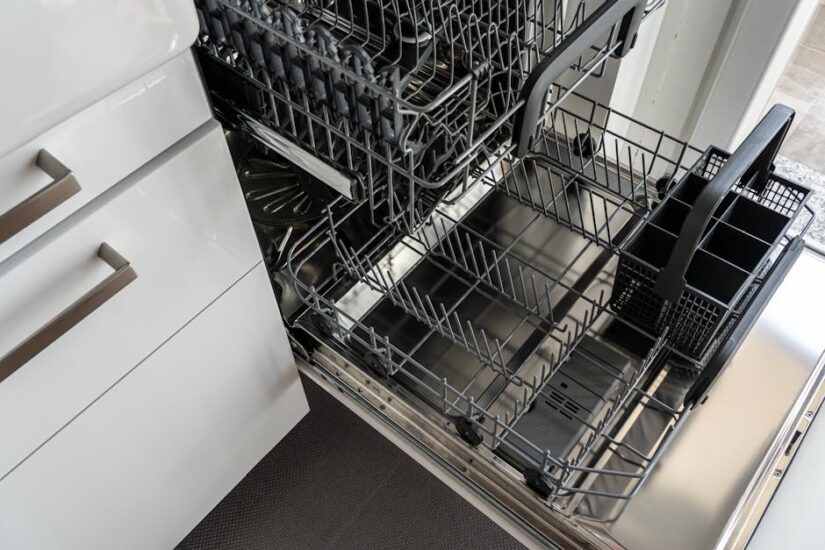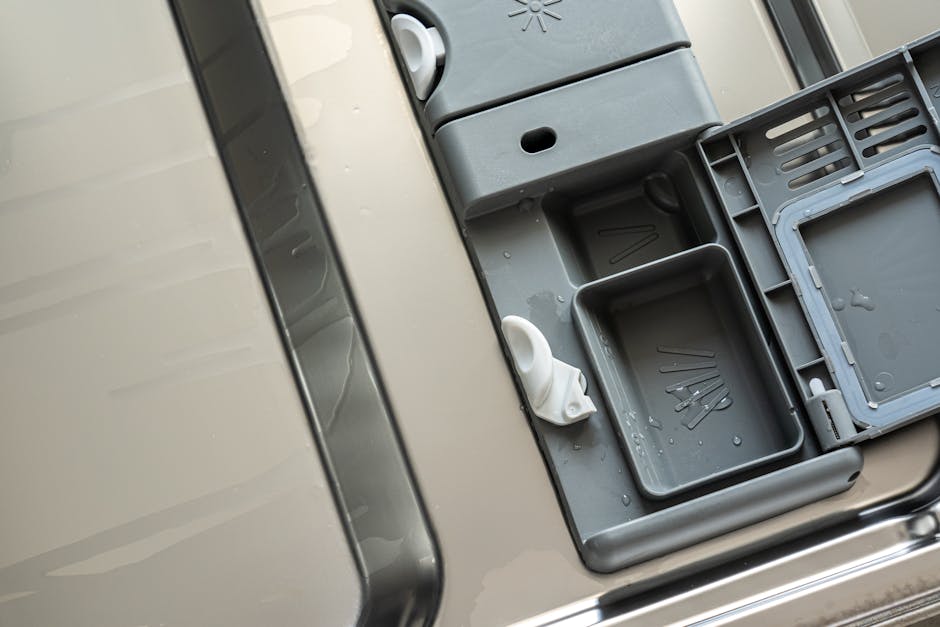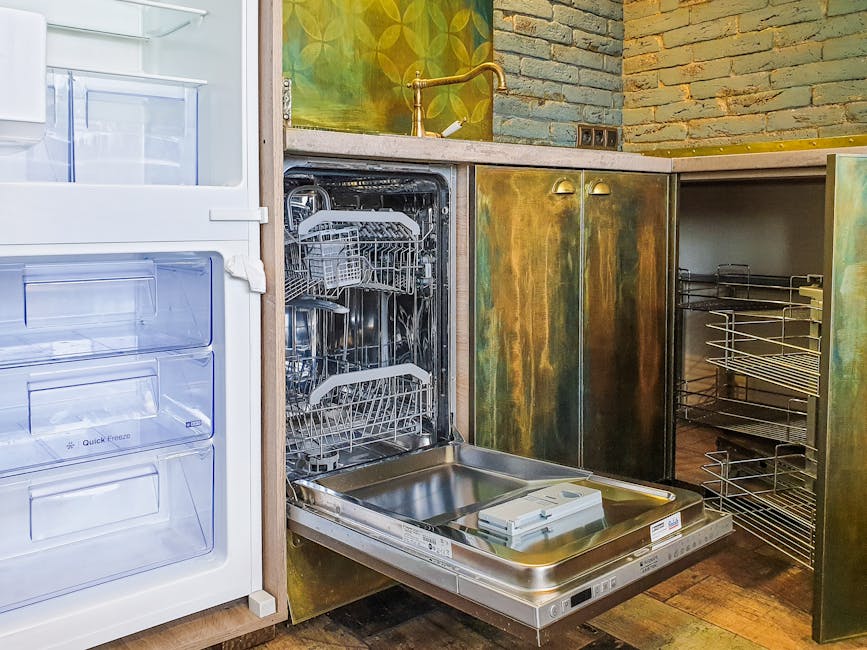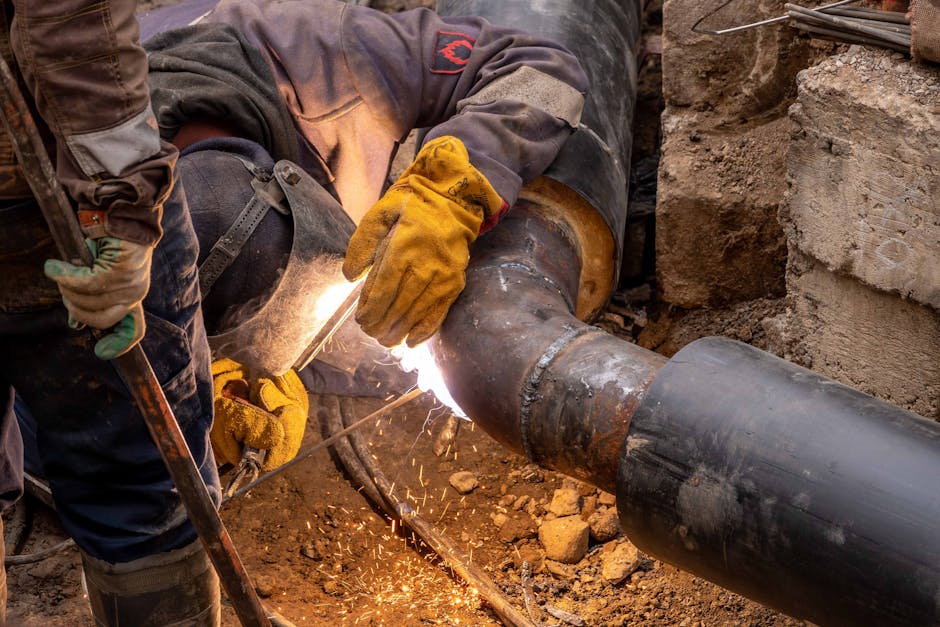Drain the Grime: Mastering Dishwasher Drain Cleaning
By Brian on April 11, 2025

Why Cleaning Your Dishwasher Drain Is Essential
A clean dishwasher drain is crucial to avoid standing water, foul odors, and poorly cleaned dishes. Fortunately, it’s easy to fix a clogged dishwasher drain.
Here’s how to quickly clean dishwasher drain issues:
- Remove and clean the dishwasher filter — usually found on the bottom of the dishwasher.
- Check and clear drain hose — disconnect and remove any debris or blockages.
- Inspect the garbage disposal and air gap — ensure they’re clear to allow proper drainage.
- Flush with baking soda and vinegar — this natural combo helps break down residual grime.
Cleaning your dishwasher drain regularly helps maintain efficiency and extends the appliance’s lifespan.
Below is a clear, helpful infographic that visually summarizes the dishwasher drainage system, making it easy to keep your appliance running smoothly:

Understanding How Your Dishwasher Drains
Before you can effectively clean dishwasher drain issues, it helps to know how your dishwasher’s drainage system works. Don’t worry—no plumbing degree required! Let’s break it down simply and clearly.
When you run your dishwasher, water needs to drain out efficiently after each cycle. To do this, several key parts work together behind the scenes:
First, there’s the drain pump. Think of it like the heart of your dishwasher’s drainage system—it pumps water out of the appliance and into the drain hose. When your dishwasher runs, you might even hear a quiet hum—that’s the pump doing its job.
Next up is the drain hose. This flexible, ribbed plastic tube carries wastewater from your dishwasher to its final destination—usually your sink’s drainpipe or garbage disposal. This hose sees a lot of action and is a common place where pesky clogs can form.
Often, dishwashers are connected directly to the garbage disposal. This connection lets food particles pass smoothly into the disposal unit, where they’re ground up and washed safely away. If this connection gets blocked, you’ll quickly notice water pooling inside your dishwasher.
Another important piece is something called an air gap. You’ve probably noticed this little cylindrical device near your kitchen faucet (one homeowner humorously described it as looking like “R2-D2”). Its job is simple but crucial—it prevents dirty water from flowing back into your dishwasher, keeping your dishes sanitary and safe.
In some dishwasher setups, instead of an air gap, you may find a check valve. It performs a similar function, allowing water to flow out while blocking any unwanted backflow.
Understanding these key parts makes troubleshooting drainage issues easier. As one plumbing expert wisely noted, “When dishwashers fail to drain correctly, they can create a real inconvenience in your kitchen.” Knowing your dishwasher’s parts helps you zero in on the problem quickly.
One final tip: your dishwasher usually runs a short water refill cycle at the end of washing. This fast rinse keeps the pump’s seals wet, helping them last longer. Seeing water briefly at the end of the cycle is totally normal, so don’t panic!
But if water consistently stays pooled inside your dishwasher after cycles complete, it’s time to investigate further. The good news? With your newfound dishwasher know-how, you’re already one step closer to solving your drainage issues quickly and effectively.
Signs Your Dishwasher Drain Needs Cleaning
How do you know if your dishwasher needs a little extra attention? Thankfully, your dishwasher will give you clear signs—some more obvious (and unpleasant!) than others. Here’s how to spot when it’s time to clean dishwasher drain issues before they get worse:
Standing Water
Nothing ruins your day quite like opening your dishwasher to find a pool of murky water still lurking at the bottom. If you regularly see an inch or more of water left behind after a cycle finishes, that’s a clear signal your drain needs some TLC.
Water pooling at the bottom isn’t just an inconvenience—it can lead to mold, mildew, and unwanted bacteria growth if you ignore it. So, if your dishwasher seems more like a tiny indoor pond lately, it’s definitely time to investigate and clean out the drain.
Unpleasant Odors
Ever opened your dishwasher expecting the fresh scent of clean dishes, only to be greeted by a smell resembling old eggs or rotten food? Yeah, not exactly the scent of freshness you hoped for.
This foul odor happens because leftover food bits, grease, and grime get lodged in your dishwasher drain. Over time, these particles break down and create a nasty smell. If your dishwasher is giving your kitchen a less-than-pleasant aroma, don’t worry—it’s just gently reminding you to clean your dishwasher drain.
One homeowner humorously shared their experience: “I’m no expert, but after chatting with my neighbor who is a plumber, it turns out that funky smell was simply my dishwasher’s way of saying, ‘Hey, clean my drain already!'”
Dishes Not Cleaned Properly
Maybe you’ve noticed your dishes aren’t sparkling like they used to. Instead, they’re emerging from the dishwasher cycle with streaks, spots, or leftover food particles. If your dishwasher drain is clogged, water can’t circulate and drain properly during the wash cycle. This leads to poorly cleaned dishes and even residue left behind.
And it’s not just the visual clues—your dishwasher might start behaving oddly too. Does it seem louder, make unusual noises, or take longer to finish a cycle? These symptoms also indicate your dishwasher is struggling against a partially clogged drain.
Paying attention to these warning signs helps you tackle issues early, saving you from bigger headaches later on. If you’ve noticed any of these symptoms and cleaning your dishwasher drain hasn’t solved the issue, don’t hesitate to reach out to the plumbing experts at Go Pro Plumbing. We’re here to help with same-day service, keeping your kitchen running smoothly.
Common Causes of Dishwasher Drain Clogs
Knowing the main reasons behind dishwasher drain clogs can help you prevent problems down the road. After all, it’s no fun opening your dishwasher to find dirty dishes and standing water. Let’s explore some typical culprits behind a blocked dishwasher drain.
Food Particles
Food debris is by far the most common cause of dishwasher drain issues. Even tiny particles can become big troublemakers over time. Tough food bits—like popcorn kernels, seeds, or even paper labels from jars—can easily get stuck in the drain filter or pump. Then suddenly, your dishwasher isn’t draining properly.
One homeowner even finded a sneaky grapefruit seed hiding in their dishwasher pump. Another found a pistachio shell lodged in an elbow fitting, causing their dishwasher drain to act like a clogged pipe. The lesson here? Always scrape food off your dishes before loading them, and you’ll greatly reduce the chance of a blocked drain.
Grease Buildup
Grease and oils from cooking might seem harmless, but over time they create a sticky residue in your dishwasher’s drainage system. This residue attracts more dirt and debris, eventually narrowing your drain until it’s completely clogged.
Interestingly, dishwashers actually rely on a small amount of grease to prevent excessive foaming during cycles. However, too much grease isn’t good—think of it as a little pizza grease being fine, but pouring leftover bacon grease down the drain is asking for trouble.
Clogged Filter
Your dishwasher’s filter is designed specifically to trap food particles and keep them from entering the drain. But it can’t do its job if it’s already full of debris. A neglected, clogged filter will quickly cause drainage issues.
Regularly checking and cleaning your dishwasher filter is an easy step. If you’re not sure how, don’t worry—we’ll show you exactly how to clean dishwasher drain components in the next section.
Blocked Drain Hose
The drain hose carries wastewater from your dishwasher to your sink drain or garbage disposal. Over time, the hose can become kinked, blocked by debris, or restricted by mineral buildup—especially if you live in an area with hard water.
One homeowner fixed their dishwasher drainage issue simply by adjusting the drain hose. They rerouted it higher, near counter level, preventing dirty water from flowing backward into the dishwasher. Smart move!
Issues with Garbage Disposal
Believe it or not, your garbage disposal can affect your dishwasher’s drainage, especially if your dishwasher connects directly to it. Here’s an important tip: if you’ve recently installed a new garbage disposal, make sure the small knock-out plug inside has been removed. Many people overlook this simple step, only to find their dishwasher won’t drain properly.
Also, remember to run your garbage disposal before starting your dishwasher. If the disposal is jammed or full of food debris, your dishwasher might not drain well. One user humorously admitted, “If I don’t run the disposal before the dishwasher, I’ll be greeted by standing water—and a grumpy spouse!”
By understanding these common culprits, you’ll be better equipped to maintain a clean dishwasher drain. Next, we’ll walk you step-by-step through exactly how to clear those stubborn clogs yourself.

How to Clean Your Dishwasher Drain
Now that we’ve explored the common culprits behind dishwasher drain clogs, it’s time to take action! Cleaning your dishwasher drain may not be your idea of fun, but with a few simple steps, you’ll have your appliance running smoothly again in no time. Before diving in, always be safe—disconnect your dishwasher from power by unplugging it or turning off its circuit breaker.
Step 1: Gather Your Tools and Supplies
Starting with everything you need makes the job a breeze. Grab a pair of rubber gloves to protect your hands, a screwdriver for removing parts if needed, and some towels or a shallow pan to catch water spills. A cup, turkey baster, or wet/dry vacuum will help remove standing water from the bottom of the dishwasher.
You’ll also want a soft brush (like an old toothbrush) and a wire hanger or drain snake for stubborn blockages. Don’t forget the dynamic duo: baking soda and white vinegar—perfect for natural cleaning. Lastly, have some dishwashing liquid and a bucket handy to deal with debris and soaking.
As one homeowner wisely shared, “In just a few minutes, and with less than $5 worth of supplies, your dishwasher will look and smell brand new again!”
Step 2: Clean the Dishwasher Filter
Your dishwasher filter plays a starring role in keeping things clear—but it can easily become clogged. Let’s get it sparkling again.
First, remove the bottom dish rack to access the filter assembly. Usually, this filter sits at the bottom center of the dishwasher tub and looks like a small cylinder. Give it a twist counterclockwise, and it should lift right out. (Check your dishwasher’s manual if you’re unsure.)
Rinse the filter under warm water to remove loose debris. Soaking it in hot water mixed with a drop or two of dishwashing liquid for about 10 minutes will loosen tougher grime. Now gently scrub it with your soft brush, paying close attention to the mesh and hidden corners where food loves to hide.
Before putting the filter back, check the drain area underneath where it sits. Remove any visible debris. Twist the clean filter clockwise into place until it locks securely. Cleaning your dishwasher filter monthly is the easiest way to prevent larger issues with your clean dishwasher drain down the line.

Step 3: Check and Clean the Drain Hose
If cleaning the filter didn’t solve your drainage woes, the next suspect is the drain hose. Before you begin, turn off the water supply and disconnect power once again.
Carefully pull out your dishwasher from under the countertop or cabinet to see the hose clearly. It’s typically a corrugated plastic tube connecting your dishwasher to either the garbage disposal, sink drain, or air gap. Place towels or a shallow pan under connections before disconnecting both ends—you don’t want any unexpected water surprises!
Examine the hose closely for kinks, twists, or visible clogs. To clear it out, run water in the opposite direction of normal flow or gently push a straightened wire hanger through to remove stubborn blockages. If mineral buildup or grease deposits are an issue, soaking the hose in hot water and vinegar can do wonders.
When reconnecting the hose, ensure it’s straight and secure at both ends. A plumber once shared this smart tip: “Snap a quick picture of your hose connections before disconnecting. Trust me—it’ll save you frustration later!” If your hose looks worn or clogs frequently, it might be time to replace it entirely.
Step 4: Inspect and Clear the Garbage Disposal and Air Gap
Since your dishwasher drain is often connected to a garbage disposal or air gap, you’ll want to check these too.
Start with the garbage disposal. Run it with cold water to see if there’s a blockage. If you recently had a new disposal installed, make sure the knockout plug was removed. (This small step is often overlooked and can save you from a lot of headaches!) It’s also helpful to run the disposal briefly before starting your dishwasher—this clears any lingering debris.
Next, take a look at the air gap—a small chrome cylinder mounted on your sink top (the one that resembles R2-D2). Remove the decorative cap by twisting or pulling gently upward. Check inside for debris; use a pipe cleaner or bottle brush to clean it thoroughly. A clean air gap ensures water flows properly and prevents messy backups onto your countertop.

Step 5: Flush with Baking Soda and Vinegar
You’ve tackled the filter, hose, garbage disposal, and air gap—great job! Now, let’s finish strong with a natural cleaning flush.
With your dishwasher empty and filter securely back in place, sprinkle a quarter cup of baking soda directly onto the drain area at the bottom. Follow this by pouring half a cup of white vinegar over the baking soda. The foamy reaction you’ll see helps break down remaining grease, grime, and debris.
Let this powerful combo sit for about 10-15 minutes, then run a hot water rinse cycle. This final flush removes any lingering buildup and leaves the interior fresh and odor-free. If you want to deep-clean the entire dishwasher interior, place a bowl of white vinegar on the top rack and run another hot wash cycle. Your dishwasher will thank you!
One happy homeowner reported after trying this method: “It looked (and smelled) brand new again!”
While commercial dishwasher cleaners are safe to use occasionally, remember: Never use regular drain cleaners in your dishwasher. They’re too harsh and can damage both your appliance and plumbing.
With these simple steps, you now have all you need to maintain a clean dishwasher drain. However, if you’ve tried everything and drainage issues persist, it may be time to call a plumbing professional. Go Pro Plumbing offers same-day service to help you quickly get your kitchen back in tip-top shape.
Tips to Prevent Future Dishwasher Drain Clogs
Let’s be honest—dealing with a clogged dishwasher is nobody’s idea of a good time. The good news? A few simple habits can keep those clogs at bay and save you from future headaches. Think of these tips as an ounce of prevention that’s worth a pound of cure!
Scrape Dishes Before Loading
Your dishwasher isn’t a garbage disposal in disguise. Taking just a few seconds to scrape those dinner plates before loading them can make a world of difference for your clean dishwasher drain.
Here’s a surprising twist though—you don’t need to pre-rinse everything until it sparkles. As one expert puts it, “Scrape off the chunky stuff but leave on the sauce!” That thin layer of food residue actually helps your detergent work more effectively. Who knew your dishwasher actually needs a little something to chew on?
Run Hot Water Before Starting
This simple trick is a game-changer! Before hitting that start button, run your kitchen tap until the water gets hot. Why? This ensures your dishwasher begins its cycle with hot water rather than waiting for cold water to heat up.
Hot water dissolves grease and food particles much more effectively, giving your drain a fighting chance to stay clean. As a bonus, one expert points out that “running hot water through your kitchen faucet before turning the dishwasher on increases the life of heating coils.” Two benefits for the price of one!
Use the Correct Detergent
That bargain dish soap might be great for hand-washing, but it’s a disaster waiting to happen in your dishwasher. Always use detergent specifically designed for dishwashers—your appliance and your clean dishwasher drain will thank you.
“Today’s machines use automatic dishwasher detergents to work, which don’t produce suds,” explains one appliance expert. “Powders are preferred, as too much liquid can be added to the dispenser.” Those excessive suds from regular dish soap can actually interfere with proper drainage and leave you with a sudsy mess.
Run Your Garbage Disposal Regularly
If your dishwasher and garbage disposal are connected (as many are), they’re more like siblings than distant cousins. What affects one affects the other. Make it a habit to run your garbage disposal before starting your dishwasher cycle.
One homeowner learned this the hard way: “If I do not run the garbage disposal before the dishwasher, it will not drain properly.” A quick flip of the disposal switch clears the path for your dishwasher’s wastewater to flow freely.
Clean the Filter Monthly
Your dishwasher filter is the unsung hero of maintaining a clean dishwasher drain. Yet it’s often forgotten until problems arise. Make a monthly date with your dishwasher filter—it only takes a few minutes, but prevents hours of frustration later.
“Regular monthly cleaning of the dishwasher will usually prevent the need to clean a dishwasher drain,” confirms one expert. Mark it on your calendar, set a phone reminder, or link it to another monthly habit so you don’t forget.
Deep Clean Every Three Months
Even with regular maintenance, your dishwasher benefits from a quarterly deep clean. Think of it as a spa day for your appliance! Use the baking soda and vinegar method we covered earlier, or try a commercial dishwasher cleaner designed for this purpose.
One seasoned homeowner recommends this practical schedule: “Weekly – rinse/scrub out the drain cover, Monthly – refill the rinse cup, Every 3-6 months – do a full cleaning with dishwasher cleaner.” Following this routine keeps everything running smoothly and extends the life of your appliance.
Check for Hard Water Issues
If you live in an area with hard water (and many of us in Northern California do), mineral deposits can slowly build up in your dishwasher’s drain system. These deposits narrow the drainage pathways over time, eventually leading to clogs.
Consider using a water softener or a dishwasher cleaner specifically designed to combat hard water buildup. These products help dissolve mineral deposits before they can cause drainage problems, keeping your clean dishwasher drain flowing freely.

With these simple preventive measures, you’ll spend less time troubleshooting and more time enjoying the convenience of your dishwasher. A little regular maintenance goes a long way toward keeping your kitchen running smoothly!
When to Call a Professional Plumber
While DIY approaches can solve many dishwasher drain problems, sometimes you need professional expertise. Knowing when to call Go Pro Plumbing can save you time, prevent further damage, and potentially extend your appliance’s lifespan.
Persistent Drainage Issues
You’ve cleaned the filter, checked the hose, cleared the garbage disposal, and tried the baking soda and vinegar trick—yet water still pools at the bottom of your dishwasher. When clean dishwasher drain methods don’t resolve the issue, deeper problems may be lurking.
“If the clog persists despite following these steps,” one expert cautions, “consulting a professional for further assistance is advisable.” The problem might involve the drain pump, internal valves, or electronic components that require specialized knowledge and tools to diagnose and fix.
Unusual Noises or Error Codes
Has your dishwasher started making concerning sounds? Strange grinding or humming during the drain cycle isn’t normal. Similarly, if your digital display shows error codes related to drainage issues, your dishwasher is essentially asking for professional help.
These symptoms often indicate mechanical failures that go beyond simple clogs. A trained technician can interpret these signals correctly and address the root cause rather than just treating symptoms.
Water Leaking from the Dishwasher
Finding puddles around your dishwasher is never a good sign. Water escaping from underneath the appliance during operation suggests potentially serious problems with the drain system, pump, or internal seals.
This situation demands immediate professional attention—not just to fix your dishwasher, but to prevent water damage to your floors, cabinets, and the structural elements of your home. What starts as a small leak can quickly become an expensive repair project if left unaddressed.
Electrical Issues
When your dishwasher’s drain cycle fails to activate at all, you’re likely facing an electrical problem. For safety reasons alone, electrical issues should be handled by professionals. Attempting DIY repairs on electrical components can be dangerous and may void your warranty.
At Go Pro Plumbing, we offer same-day service throughout Northern California, including Sacramento and Rancho Cordova. Our licensed plumbers bring extensive experience diagnosing and repairing all types of dishwasher drain issues, from simple clogs to complex mechanical failures.

While dishwasher repairs typically cost between $160 and $300 on average, with specific components like pump replacements ranging from $150 to $350, this investment is worthwhile. Professional repairs extend your appliance’s life and prevent potentially costly water damage to your home.
Faulty plumbing connections can sometimes be the hidden culprit behind persistent dishwasher drain problems. Our technicians are trained to look at the bigger picture, ensuring that all components of your plumbing system work together properly.
When in doubt, reaching out to a professional plumber can save you both time and money in the long run. A properly functioning dishwasher not only makes your life easier but also uses water and energy more efficiently—something that benefits both your wallet and the environment.
Conclusion
Keeping a clean dishwasher drain is one of the easiest ways to ensure your dishwasher stays efficient, odor-free, and reliable for years. Understanding your dishwasher’s drainage system and following our simple guide can help you tackle most common drainage issues quickly and easily. With regular care, your dishwasher can perform like new and save you from unnecessary headaches.
Regular maintenance doesn’t have to be a chore. A quick monthly filter cleaning and a deeper clean every few months using baking soda and vinegar can prevent many of the problems homeowners frequently face.
To keep your dishwasher in top shape, make sure to scrape dishes before loading—but don’t remove all food residue, as dishwasher detergents need a bit of grime to do their best work. Run your garbage disposal regularly, especially before starting a dishwasher cycle, to clear away potential blockages. Always choose the correct dishwasher detergent to avoid those pesky suds that interfere with proper drainage.
If your installation includes an air gap—the small, R2-D2-looking device on your sink—regularly check and clean it for optimal water flow. These simple habits can significantly reduce the chances of clogs, odors, and poor dishwashing performance.
Of course, some issues may still pop up, despite your best efforts. If you experience persistent drainage problems, unusual noises, leaks, or electrical issues, it might be time to call in the pros. At Go Pro Plumbing, our friendly and experienced team can quickly diagnose and solve your dishwasher woes. We proudly serve Northern California, including Sacramento and Rancho Cordova, offering same-day service for added convenience and peace of mind.

In the end, a small investment in regular dishwasher maintenance can save you significant time, hassle, and money down the road. As one expert wisely stated, “Regular maintenance of your dishwasher drain keeps your appliance running efficiently and extends its lifespan.”
For more information about our professional drain cleaning services or to schedule an appointment, visit us online or give us a call today. We’re here to help you keep your plumbing—and your dishwasher—running smoothly.
